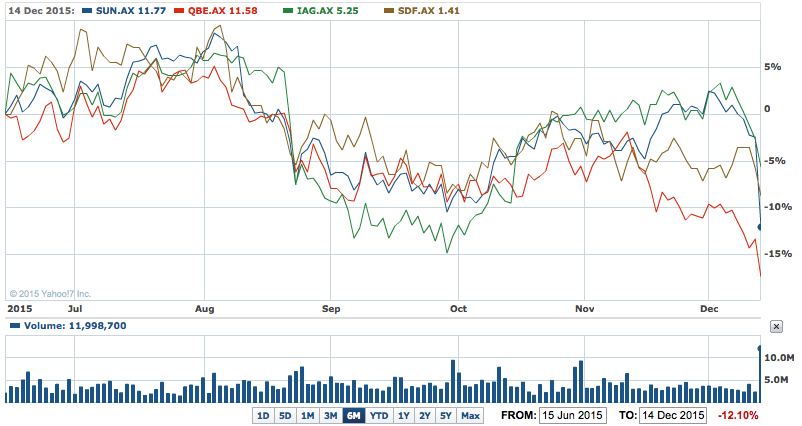Suncorp (SUN) shares fell more than 10% at one stage yesterday after the company joined QBE and Insurance Australia Group (IAG) in downgrading its December half year insurance profit guidance and performance data.
Suncorp said in an early morning statement to the ASX that its underlying insurance trading ratio (ITR) for the half ending December 31 will be about 10%, compared to 12.8% for the first half of 2014-15.
The company blamed the downgrade on higher than expected losses in commercial insurance, the continuing impact of a string of natural disasters earlier this year, the falling Australian dollar and poor investment yields
New CEO Michael Cameron, who started on October 1, said in the statement,"These increased costs will have a significant impact on the underlying margin in our personal insurance business”.
Suncorp operates through a group of insurance brands including AAMI, APIA, GIO, Shannons, Vero and Suncorp.
Despite QBE downgrading its outlook in the past six weeks for similar reasons – especially the impact of the string of natural disasters, investors were taken by surprise and sold off Suncorp shares.
After an hour of trading on the ASX yesterday, Suncorp shares were down 10.3% at $11.71. The shares ended the day down 8.9% at $11.89.
The surprise news prompted a sell-off in other insurers, with QBE off 4.1%, IAG down nearly 3% and Steadfast Group off 3.1%.
IAG shares were off 5% at one stage yesterday and some analysts wonder when it will match Suncorp’s downgrade seeing they operate in similar markets in Australia, especially on the East Coast.
SUN, IAG, QBE, SDF 6M – Suncorp downgrade spooks insurers

Suncorp said it has reacted to the weakness by raising some premiums to help offset the increased number and cost of weather-related claims from storms in Queensland and NSW (The Sydney Anzac Day hail storm) and cyclones such as Marcia.
That is expected to help the company report an increase in gross written premiums when it reports its interim figures in February.
“While the industry remains very competitive, costs have been increasing as a result of the lower Australian dollar and the impact of the $4 billion of weather events during 2015,” Mr Cameron said.
Mr Cameron said the insurance trading ratio had also been hit by a $75 million increase in natural hazards allowance, higher than anticipated large loss experience in commercial insurance, an increase in compulsory third party claims in NSW and lower investment yields.
Mr Cameron said the insurer was in good shape despite the short-term problems, with $170 million (the target set by the previous CEO Patrick Snowball) worth of savings to be delivered by 2018 through the group’s optimisation program.
“I’m confident we can address these challenges and continue to drive changes that improve outcomes for our customers, shareholders and other key stakeholders,” he said in yesterday’s statement.
Australian insurers were slugged with claims following a string of violent storms earlier this year.
Heavy winds and rain hammered Sydney, the Hunter and Central Coast regions in April. There were also severe floods and loss of life in the northern parts of the Hunter at the same time.
Other events included Tropical Cyclone Marcia, which hit the central Queensland coast in February, and a severe Brisbane hailstorm in November 2014.
The cost of these and smaller natural disasters (such as bushfires in South Australia) have seen claims spiral to around $4 billion.













